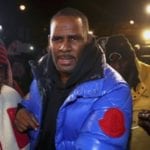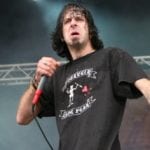 Weird Stuff
Weird Stuff  Weird Stuff
Weird Stuff  Animals
Animals 10 Inspiring Tales of Horses Being Human
 Mysteries
Mysteries Top 10 Haunting Facts About the Ghost Ship MV Alta
 History
History 10 Surprising Stories About the Texas Rangers
 Humans
Humans 10 Philosophers Who Were Driven Mad by Their Own Theories
 Miscellaneous
Miscellaneous 10 Video-Game-Worthy Weapons and Armors from History
 Weird Stuff
Weird Stuff 10 Psychics Who Accurately Predicted Wartime Events
 The Arts
The Arts 10 Pieces of Art Inspired by a Broken Heart
 Health
Health 10 Science Fiction-Sounding New Medical Treatments
 History
History 10 Surprising Facts About the Father of Submarine Warfare
 Weird Stuff
Weird Stuff 10 Times Real Laws Were Based on Bizarre Hypotheticals
 Animals
Animals 10 Inspiring Tales of Horses Being Human
 Mysteries
Mysteries Top 10 Haunting Facts About the Ghost Ship MV Alta
Who's Behind Listverse?

Jamie Frater
Head Editor
Jamie founded Listverse due to an insatiable desire to share fascinating, obscure, and bizarre facts. He has been a guest speaker on numerous national radio and television stations and is a five time published author.
More About Us History
History 10 Surprising Stories About the Texas Rangers
 Humans
Humans 10 Philosophers Who Were Driven Mad by Their Own Theories
 Miscellaneous
Miscellaneous 10 Video-Game-Worthy Weapons and Armors from History
 Weird Stuff
Weird Stuff 10 Psychics Who Accurately Predicted Wartime Events
 The Arts
The Arts 10 Pieces of Art Inspired by a Broken Heart
 Health
Health 10 Science Fiction-Sounding New Medical Treatments
 History
History 10 Surprising Facts About the Father of Submarine Warfare
10 Criminals Who Launched the Careers of Famous Musicians
The expression “crime does not pay” is wrong. Crime can pay very well. The royalties off crimes can leave quite the bounty. The actions of the following ten criminals resulted in hugely popular songs that still turn a profit. Some of the most famous musicians of all time got their start from people more occupied with committing crimes.
Related: 10 Bizarre Times Musicians Got Into Trouble With The Authorities
10 Anders Klarström
Anyone that gushed over boybands in the 1990s probably did not check out the Nazi punk band Commit Suicide. Ulf Ekberg is likely the only fan in that Venn Diagram. Along with Anders Klarström—the future head of the Swedish Democrats—Ekberg used Commit Suicide to promote far-right ideology. The radical outfit was hardly poised to top the hit parade with lyrics like “Men in white hoods march down the road, we enjoy ourselves when we’re sawing off n—rs’ heads/ Immigrant, we hate you! Out, out, out, out! Nordic people, wake up now! Shoot, shoot, shoot, shoot!” Klarström’s violent lyrics were not artistic hyperbole. He threatened to burn Jewish theater director Hagge Geigert alive. In 1986, Klarström’s militia-like arsenal of weapons was discovered. The band disbanded after Klarström was convicted for illegal firearm possession.
Down a group, Ekberg needed a new outlet. In August of 1990, Jonas Berggren asked his friend Ekberg to temporarily replace an absent bass player. A few weeks later, the lineup became permanent. With Berggren’s two sisters singing lead, the new group was called Ace of Base. [1]
It is unfair to dismiss Ace of Base as a fad. The brief mania in the early ’90s was incredibly influential. The giddy maximalist sound of hits like “The Sign” or “All That She Wants” was crafted by a team of Swedish songwriters for hire. By the decade’s end, the bombastic Nordic sound dominated the airwaves. The ultimate success of that evolution is discussed further in the article.
9 Raffaele Minichiello
Technically, Raffaele Minichiello is a musician in his own right. He runs a YouTube channel showing off his accordion prowess. However, his musical skill is often ignored for a bigger claim to fame. He committed the longest airplane hijacking in world history.
On October 30, 1969, Minichiello boarded TWA Flight 85 from San Francisco to Los Angeles with an M1 rifle packed in his luggage. Gun pressed against a stewardess’s back, he ordered the plane reroute to Rome. Over the next 18 hours and 22 minutes, the flight traveled nearly 7000 miles. When he landed in Italy, he was arrested after an extensive manhunt. He only served one and half years in prison.
Among the forty passengers taken captive that night were the members of the 1960s pop group Harpers Bizarre. As a sign of good faith, Minichiello released the passengers in Denver. Upon release, reporters tailed Harpers Bizarre to get their story. Unfortunately, the band could not capitalize on their new notoriety. The previous experience made them reluctant to travel. The lack of touring caused the group to infight. Further conflicts over management forced a breakup.
One former bandmember, Ted Templeman, was now desperate for a job. Less than a year after the hijacking, Templeman started work in an entry-level A & R position for Warner Brothers Records. He listened to demo tapes sent in by unknown wannabes. Among the scores of amateurs, two acts that Templeman discovered found future success. He launched Yacht Rock forefathers The Doobie Brothers and hair metal pioneers Van Halen into the mainstream. [2]
8 Sabrina Jackson’s Killer
When someone dies, custom says to rest coins on their eyes. No one placed any quarters on Sabrina Jackson’s lifeless body when it was discovered in 1983. Nor did anyone find the culprit responsible. All authorities could go off was a rumor. It was hypothesized that she was murdered in a retaliatory killing over her cocaine trafficking. The assault was more calculated than the standard drive-by. A guest came into her house intending to kill. At some point, they drugged her drink. In her unconscious state, they turned on the gas and slithered out.
Her eight-year-old son Curtis was wayward. His father had abandoned him. His mother was killed in a malicious attack. His grandmother was left to watch him. Curtis felt like a strain on his elderly caretaker. To relieve some of her troubles, he brought in extra income by selling drugs. By nineteen, he ascended the ranks to become his neighborhood’s kingpin. This success came with a few stints in jail for minor offenses. When his son, Marquise, was born, he swore off the trade. He would not let his child grow up without a parent as he did. Instead, he committed to making a living on a skill he picked up in jail, rapping. [Source 6] For a career marred by death, it is appropriate that he choose a name as valuable as two quarters resting on a pair of eyes, 50 Cent. [3]
7 Richard Mason’s Killers
Kit Lambert never wanted to get into music. The son of a composer and actress, he thought he would have a simple life among educated high society. In May 1961, he joined two Oxford friends, Richard Mason and John Hemming, on an expedition to discover the source of the Iriri River in the Amazon. They did not succeed. On September 3, Mason went searching for some food. Unknowingly, he stumbled upon the elusive Panará tribe. Fearful of all outside contact, the cannibalistic Amazonians stabbed and killed him.[4] Police initially arrested Lambert and Hemming on the assumption that they made the story up to get away with murder. Expedition backers from the Daily Express secured their release.
Back in England, Lambert changed careers. He became an assistant director on films, like From Russia with Love and The L-Shaped Room. On the latter’s set, he met fellow assistant director Chris Stamp. Stamp convinced Lambert to check out a band he liked called The High Numbers. Lambert and Stamp decided the group could be the subject of a potential documentary. Charmed by the backstage antics, the two eventually abandoned their filmmaking aspiration. Lambert became the band’s manager on the condition that they change their name. He suggested The Who. Kit Lambert shaped one of the greatest rock bands ever, all so that he wouldn’t be food again. Yeahhhh! [5]
6 Jim Gordon
As a ubiquitous session drummer in the 1970s California scene, it is impossible to count how many records bear Jim Gordon’s name. That number skyrockets if one adds samples, if for just one track. Dubbed “the national anthem of hip-hop,” his near-universal drum break on the Incredible Bongo Band’s cover of “Apache” has been sampled more than seven hundred times. His handiwork propelled two of the most consequential artists in early hip-hop. Popularized by DJ Kool Herc, “Apache” was the go-to party starter of Herc’s legendary merry-go-rounds. It was an omnipresent sound at hip-hop’s unofficial big bang. When “Grand Wizzard” Theodore pioneered turntablism, the first album he scratched was “Apache.” Jim Gordon’s beat carried the next 40 years of music. But his presence brings a dark legacy.
Decades of drug use destroyed Gordon’s mental health. He retired from music after imaginary voices started haunting him. After a series of violent outbursts, he was sent to a psychiatric hospital. Upon his release in 1983, he became convinced that his mother was sending these messages to torture him. She had to be silenced, permanently. After bludgeoning her with a hammer, he stabbed her to death. As of 2021, he remains committed to a mental hospital.[6]
5 King Ludwig II
King Ludwig II’s obsession with fairy tales prevented him from living happily ever after. As the ruler of Bavaria, Ludwig II wasted government funds constructing whimsical castles. Even as Prussians sieged his kingdom, he sank resources on ostentatious designs. One castle included an indoor cave on top of a man-made lake, so he would have a proper setting to dress up as his favorite opera character. Another building, Neuschwanstein, served as an architectural template for Disney World’s enchanting Cinderella Castle. There was a reason Ludwig was so drawn toward opulence. He believed he was the reincarnation of King Louis XIV of France.
Proclaiming himself a vessel for the Sun King’s spirit caused advisors to worry over his mental health. Other actions gave them pause too. He grew utterly obsessed with swans, carving the bird on every wall of his house. He talked to invisible courtiers for hours at a time. His eccentricities eventually grew more violent. He stole a citizen’s purse, strangled his brother with a rope, and orchestrated a bank robbery. Finally, in 1886, the government declared him insane. The day after he was deposed, his corpse was found floating in a pond. The doctor who diagnosed his insanity was also dead. The mysterious circumstances of the deaths have caused historians to speculate. Physicians, at the time, concluded that Ludwig killed the doctor and then drowned himself. However, conspiracies still abound.
Whatever happened to Ludwig that night cannot undo his positive impact on music history. A closeted homosexual, Ludwig showered composer Richard Wagner with gifts and money to earn his affection. Wagner denied the king’s advances but relied on his patronage. Before Ludwig discovered Wagner, Wagner considered retiring. Without any investors, he told his friend that “only a miracle can help me now or I am done for.” Ludwig’s lifelong sponsorship gave Wagner the freedom and finances to become one of opera’s great talents.[7]
4 Morris Levy
When Tommy James left for New York with a demo of “Hanky Panky,” every label he approached was eager to sign him. The next day, they all turned him down. Roulette Records strongman Morris Levy warned them that James was his next act. If they poached him, the Genovese crime family would pay them an unpleasant visit.
Convicted extortionist and connected mobster Levy ran Roulette Records as an arm of his criminal empire. He skimmed money from competitors by bootlegging their records. No one dared rip off his signees. A burned corpse of a bootlegger that crossed Levy was found in a pyre of stolen albums. A less monstrous but still legally dubious practice was payola. The mafia-controlled racket gave aligned disc jockeys sanctioned hits to promote on their show. Under Levy’s management, James’s impressive string of indelible gems got the airplay they deserved.
The relationship was hardly worth the brief fame. Nearly 40 million dollars of James’s royalties were funneled toward Levy’s prostitutes, tax shelters, and monthly dues to the Genovese family. James retaliated by pulling a gun on Levy in a drugged-out brawl. Levy yanked his most valuable artist off the ground and threw him against the wall. Trying to put pressure on Levy, the rival Gambino family placed a hit on James. James was only able to live thanks to strings pulled by another powerful friend, Vice President Hubert Humphrey. Working in that line of business takes a lot of blood and luck, crimson and clover, over and over.[8]
3 Lou Pearlman
Lou Pearlman started his career with a con. Lou Pearlman ended his career with a different con. In between, there were some songs.
His first enterprise swindled investors with a fraudulent blimp company. Recruiters financed a company that did not own a single airship. Passing off a reconstructing weather balloon to look like a blimp, he purposely sabotaged his maiden flight. The insurance payout funded borderline legitimate projects. His next idea was to operate a fleet of personal airplanes. After boyband New Kids on the Block booked a flight, Pearlman figured he could rake in millions if he formed his own group.
Pearlman created the two dominant artists of the ‘90s boyband boom, The Backstreet Boys and N’Sync. The ploy of a faux rivalry lined Pearlman’s pockets with stolen profits. When the bands finally wiggled out of their terribly constrictive contracts, they dropped Pearlman as their manager. Denied his major revenue source, he started a new con. In 2008, he was sentenced to 25 years in prison for embezzling millions in a phony retirement pyramid scheme.
Pearlman exploded the craze that Ace of Base started. Pearlman hired a then-unknown composer Max Martin to craft his records. The two’s luck split over the ensuing decades. Until Pearlman’s death in 2016, Martin hit number one every year his former boss rotted in prison. By 2021, Martin had written the third-most number-one songs of all time.[9]
2 Owsley Stanley
Hippies saw themselves as rebels against the powers in charge. Yet, their longest-lasting musical export was a product of the Central Intelligence Agency at its most villainous.
Starting in the 1950s, the CIA investigated LSD’s potential weaponized use as a truth serum. National security was too big of a priority to worry about rights like voluntary participation or informed consent. Unwitting victims were lured off the street and unknowingly slipped the drug. Behind fake walls, observers monitored their reactions. In one of the most unethical chapters in United States history, participants were raped, fell into comas, starved to death, jumped out of windows, and turned to murder. As awful as the experiment was, the CIA unwittingly catalyzed a cultural revolution.
Not all members regretted their involvement. The clandestine trials were Bohemian writer Ken Kesey’s first exposure to LSD. Having manufactured well over one million doses of the drug, MK-Ultra contact Owsley Stanley supplied Kesey and his entourage of the Merry Pranksters the potent chemicals needed for their infamous acid parties. The Warlocks, the in-house band, scored the debauched affairs with a rambling jam session resembling the drug’s hallucinatory effects. The profits of Stanley’s illegitimate business financed the Warlock’s first tours. Formlessness became the hallmark of the band, even after they changed their name to The Grateful Dead.[10]
1 Michael Maybrick
Let’s start with the inarguable and then move to the speculative. First, the obvious truth, Duke Ellington made the world a better place. Over his six-decade career, Ellington consistently reshaped jazz history. Behind his piano at the Cotton Club, Ellington popularized the Big Band sound. Manager Irving Mills signed the legend after overhearing “Black and Tan Fantasy” creep through the airwaves of a local dive bar. Ellington’s 1927 song was not strictly an original composition. Mills was attracted to Ellington’s creative juxtaposition of jazz and motifs borrowed from Michael Maybrick’s 1892 hymnal “The Holy City.”
Despite “Holy City’s” reputation as the bestselling song of the 19th century, it is hard to confirm much of its songwriter’s biography. The nagging question, especially for researcher Bruce Robinson, is—did Maybrick get away with murder?. Circumstantial evidence strongly suggests he framed his sister-in-law for poisoning his brother. Unfortunately, Maybrick’s depravity might be even worse.
In his book They All Love Jack, Robinson makes a compelling case that Maybrick was the real identity of the eternally mysterious serial killer “Jack the Ripper.” Stops on Maybrick’s concert tours corresponded to the time and place where “Jack” sent his letters. Masonic elements splattered the crime scenes. Maybrick was a high-ranking member of the fraternity. The bodies were discarded within walking distance from Maybrick’s travel lodge. Singing a song by a serial murderer turned Duke Ellington into a household name, a fate Maybrick was surely thankful he avoided.[11]








